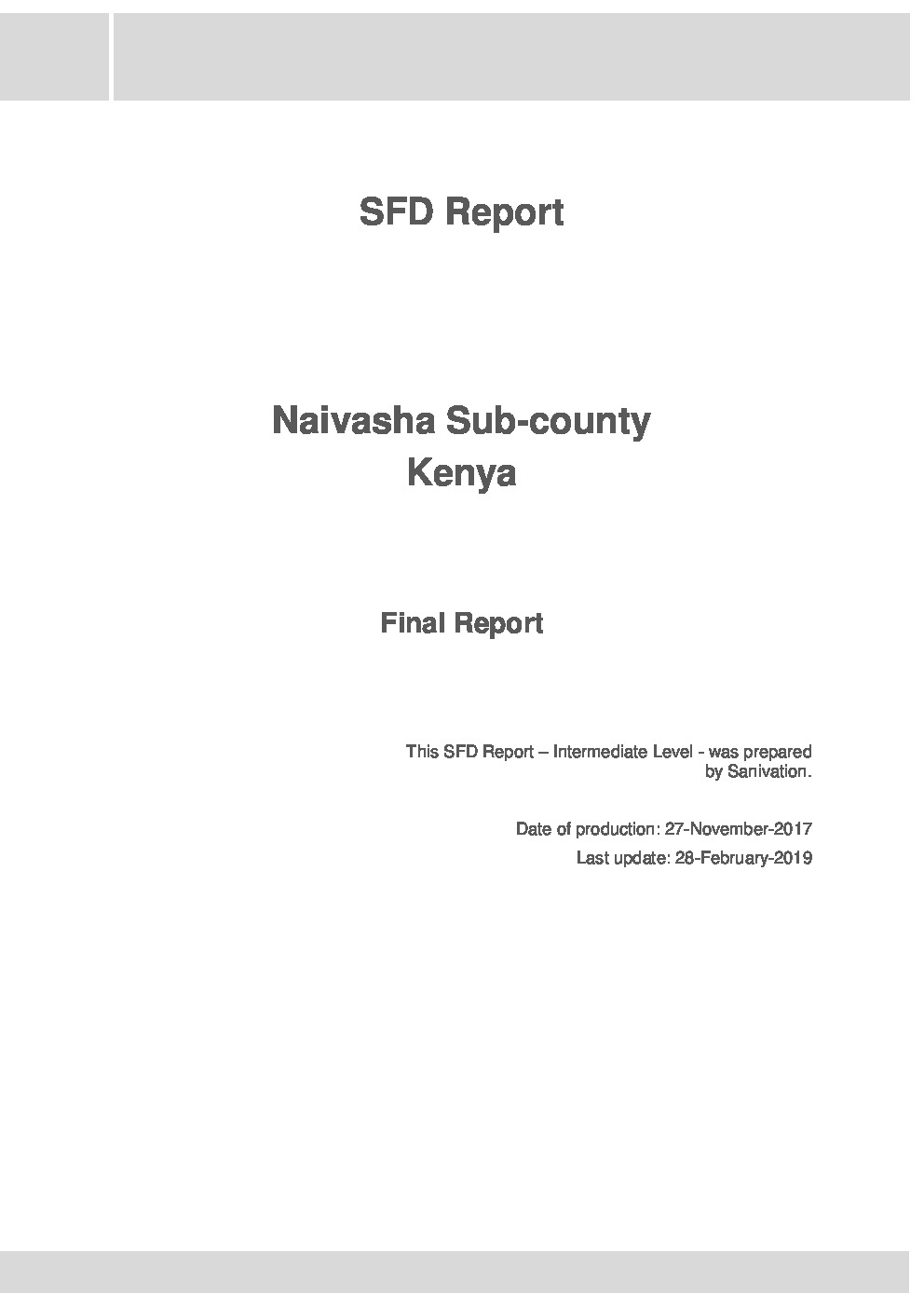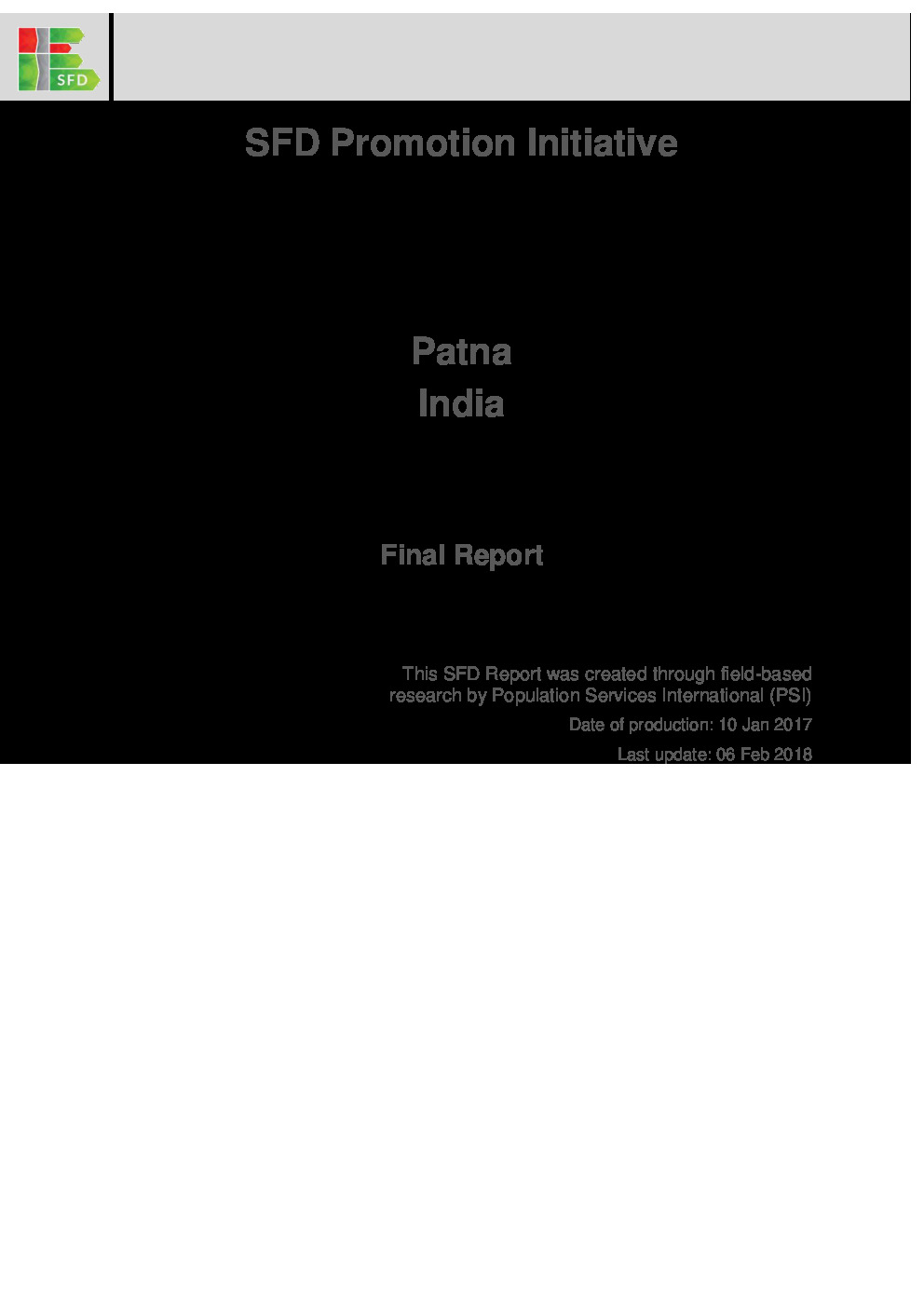-
Containment Collection and transport Treatment Disposal / Reuse
-
Capacity building Finance Information Education and Communication / Behavior Change Communication Infrastructure Policy and processes Technology
-
Access to sanitary toilets Better governance and planning Change in disease burden Collection efficiency of sanitation system Cost recovery Environmental sustainability through reuse, resource recovery, conservation Equity and social inclusion Private sector engagement Quantity of waste safely treated Sanitation practices of the supply side Sanitation practices of the end user
-
SFD Report - Naivasha, Kenya - SFD Promotion Initiative
Naivasha sub-county is one of 11 constituencies in Nakuru County, Kenya. This geographical boundary was chosen for the SFD because the local water service provider, Naivasha Water Sewerage and Sanitation Company (NAIVAWASS), is mandated to serve the sub-county. Naivasha sub-county has an estimated population of 314,052. At the time of the last census, there were an estimated 73,457 households. The final SFD matrix shows that 78% of the faecal sludge is managed unsafely. The number of people served by sewerage was 15% of the population or 47,107 people. The sewer network has been known to leak; therefore, it is estimated that 75% of sewerage is actually transported to the wastewater treatment plant.
-
SFD Report - Patna, India - SFD Promotion Initiative
Patna, the state capital of Bihar, is situated on the southern bank of Ganga River. The city is surrounded by two other rivers on two other sides: Sone River and Pun-Pun River.Patna is the second largest city in eastern India after Kolkata. For the preparation of the SFD, the territory of Patna Municipal Corporation (PMC) is selected. The total population of the city is 1.68 million with decadal growth rate of 22% and annual growth rate of 2.1%, as per the 2011 census. The population density of the PMC area is 15,640 persons per square kilometre. The total area under PMC is 109.21 km2, which is 23 km in length and 18 km wide (PMC, 2016).As per census, 92.3% of households in Patna have toilet facilities with 21.5% of the toilets connected to the sewer system, 65.5% of the toilets connected to septic tanks and 2.8% with pit latrines and other systems. Moreover, 2.4% of the households are dependent on public toilets and 5% practice open defecation.
-
SFD Report - Ramnagar, India - SFD Promotion Initiative
Ramnagar city is situated on the banks of the Ganga River in the state of Uttar Pradesh, India. The population of the city is 49,132 and its population density is 13,572 persons per sq.km (data from 2011). The slum population is 1,958,representing 3.98% of the total population. The existing sewer network covers about 70% of the households. The rest of the city (16%) is either dependent on 2/3 chambered septic tanks or pit latrines and 13% of the population practice open defecation. There is no treatment facility available for sewage and FS generated in the city and it is eventually discharged into Ganga River. Sewage is also used for irrigation during the beginning of crop sowing period which is two to three months in a year. Hence, it can be concluded that 100% of the excreta is managed unsafely.
-
SFD Report - Siddipet, India - SFD Promotion Initiative
Siddipet is a city in Siddipet district of the Indian state of Telangana. It is a municipality and the headquarters of Siddipet mandal administrative division. The city is spread over an area of 36.03 sq.km and is divided into 34 municipal wards and 12 revenue wards. Komati Cheruvu, Narsapur Cheruvu and the Yerra Cheruvu are the majorlakes of the city. The city is 110 km away from Hyderabad, the capital city of Telangana state (SM, 2015).According to the field-based research, there is no functional sewerage system available in the city. The city is entirely dependent on onsite sanitation systems (OSS) like a septic tank and pit latrines.
-
SFD Report - St. Louis, MO, USA
The City of St. Louis is located within the state of Missouri, USA. Built along the Mississippi River, it borders St. Louis County but is not a part of it. The Metropolitan St. Louis Sewer District (MSD) serves the City of St. Louis and 90% of St. Louis County, equivalent to a total of 1.3 million people. It is estimated that 90% of fecal sludge and wastewater is treated and safely managed, while the 10% that is not treated is discharged from Combined Sewer Overflows and Sanitary Sewer Overflows.Date of production: 07/07/2017
-
SFD Thinking - Resource Value Mapping based on SFDs - SFD Promotion Initiative
Inspired by the SFD, the Resource Value Mapping tool (REVAMP) is being developed at Stockholm Environment Initiative (SEI) for quickly estimating, visualizing and valuing the resources that could be recovered from a city’s organic waste streams: sewage sludge, faecal sludge, and food and other organic solid waste.There is increasing interest in the concept of the circular economy and “closing the loop” in water, energy and mineral resources. The focus here is not only to reducing social and environmental damage linked to resource extraction and waste disposal, but also in optimizing the use of resources.Additionally the tool tries to integrate the potential of the water-food-energy nexus in an urban context.
-
Supply and Demand for Improved Sanitation: Results from Randomized Pricing Experiments in Rural Tanzania.
Improving access to sanitation is a global public health priority. Sufficient consumer demand is required for sanitation coverage to expand through private provision. To measure consumer demand for hygienic latrine platform products in rural Tanzania, we conducted a randomized, voucher-based real-money sales trial with 1638 households with unimproved latrines. We also evaluated multiple supply chain options to determine the costs of supplying latrine platform products to rural households. For concrete latrine SanPlats, 60% of households were willing to pay US$0.48 and 10% of households were willing to pay US$4.05, yet the average cost of supplying the SanPlat to households was US$7.51. Similarly, for plastic sanitary platforms, willingness-to-pay (WTP) dropped from almost 60% at a price of US$1.43 to 5% at a price of US$12.29, compared to an average supply cost of US$23.28. WTP was not significantly different between villages that had participated in the National Sanitation Campaign and those that had not. Randomized informational interventions, including hygiene data-sharing and peer-based exposure to latrine platform products, had minimal effects on WTP. In conclusion, current household demand for latrine platform products is too low to achieve national goals for improved sanitation coverage through fully commercial distribution.
-
Sustainable Sanitation Newsletter 2017 (in English and French) - Issue no. 50, February 2017
Archived newsletters of the regular electronic news bulletin from the sustainable sanitation projects. These newsletters were sent to subscribed members involved in initiatives and projects in the field of sanitation. Discusses news, publications, books, studies, conferences, online information, and events
-
Sustainable Sanitation Newsletter 2017 (in English and French) - Issue no. 50, February 2017
Archived newsletters of the regular electronic news bulletin from the sustainable sanitation projects. These newsletters were sent to subscribed members involved in initiatives and projects in the field of sanitation. Discusses news, publications, books, studies, conferences, online information, and events
-
Technology Applicability Framework - Assessment of the Feacal Sludge Transer Station in Kampala, Uganda
The Faecal Sludge Transfer Station (FSTS) design is an innovation of Water for People (WfP) supported by GIZ RUWASS under a cofunding arrangement with the Swiss Development Cooperation (SDC). Under the Resource Recovery and Safe Reuse (RRR) Project Phase II, two mobile Faecal Sludge Transfer Stations have been piloted from April to June 2017 within informal urban settlements in Kampala. The Technology Applicability Framework (TAF) was applied to the FSTS to understand if it will be sustainable and scalable, if it will meet users’ needs and to generally capture experiences related to the technology drawing together the various actors involved in its introduction. This report captures the findings of an evaluation of the FSTS in Kampala after nearly three months of operation. The objectives of the TAF application are listed below:• To share experiences about the FSTS, including potential challenges and necessary improvements; • To assess the uptake of the services provided by the FSTS; • To assess the potential of the FSTS to address bottlenecks in FS management in Kampala; • To assess the readiness of the sector to take up this technology.
-
WASH in Informal Tented Settlements: Seeking Solutions in Restrictive Contexts, Bekaa Valley in Lebanon - Case study publication
Approximately 360,000 Syrian refugees have found shelter in some 5,000 informal tented settlements in Lebanon’s Bekaa Valley resulting from the refugee crisis in Syria.Seven years into the Syria crisis, the context has changed from emergency to a transitional stabilization phase.Many humanitarian agencies have provided WASH services to the refugees, however a significant share of the refugee communities remains vulnerable.
-
Waste to Energy Plant in Nashik Brochure - SNUSP II
Like many cities in India, the city of Nashik is also struggling with citywide Solid Waste and Wastewater management. Therefore, there is an urgent need for an integrated approach to solid waste and wastewater management on the one hand and control of Green House Gas (GHG) emissions on the other hand. The Waste to Energy Project in Nashik is one such solution through co-processing of septage (faecal sludge) with organic solid waste and generating energy to create a sustainable business model.Content:How the plant works: Technical approachFacts & FiguresBusiness Model
-
A Review of Shelter/WASH Delivery Methods in Post?Disaster Recovery Interventions - Pintakasi Study
Catholic Relief Services conducted an in?depth study to assess the efficiency, effectiveness and appropriateness of the modalities for delivering shelter and WASH assistance in its Typhoon Haiyan Recovery Program. This study, Pintakasi, hopes to contribute valuable lessons learned and share best practices from the program with the shelter/WASH recovery communities of practice in the humanitarian sector as a whole.
-
CLTS in Post-Emergency and Fragile States Settings - Frontiers of CLTS: Innovations and Insights 9
This issue of Frontiers of CLTS draws on the experiences of relief and development agencies which have facilitated CLTS in post-emergency and FCAS contexts. Its purpose is to contribute to understanding, and distil learning and guidance around the application of CLTS in these situations. It explores the question: How, when, and in what circumstances can a CLTSstyle process of analysis, action, and collective behaviour change be undertaken? As this question is unpacked through the various case studies and discussion, some of the challenges of the CLTS approach are considered, such as the question of inclusivity amongst particularly vulnerable groups, and the circumstances in which subsidised hardware, or other incentives, may be appropriate.
-
Composting - Sustainable Sanitation Practice 26
Besides sanitation, solid waste management plays an important role in improving the hygienic conditions in cities. There are several strong links between sanitation and solid waste management. In sanitation systems without sewers, urine, faecal matter and faecal sludge have to be collected from the single households such as solid waste. Faecal matter as well as sludge from wastewater treatment plants can be treated by composting to produce fertiliser.Issue 26 of Sustainable Sanitation Practice (SSP) is thus devoted to „Composting“. The contributions for this issue have been collected with the help of Erwin Binner from the Institute of Waste Management at the University of Natural Resources and Life Sciences Vienna (BOKU). Selected aspects of „Composing“ are described in the following four contributions:• Erwin Binner describes the fundamentals of composting and the requirements for producing good compost in the first paper.• In the second paper, the composting facility for separately collected biowaste of the City of Vienna is described by Wojciech Rogalski.• The design of a composting plant in Greece for about 77‘000 inhabitants is shown in the third paper by Christina Chroni et al.• The last paper by Christoph Engelhardt and colleagues describes field trials with compost from wastewater treatment plants in China.















